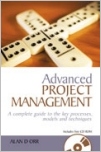| |||||
• polskie
• Zamów informacje o nowościach z wybranego tematu • kontakt |
DESIGN FOR SIX SIGMA. IN TECHNOLOGY AND PRODUCT DEVELOPMENTCREVELING C., SLUTSKY L., ANTIS D.wydawnictwo: PH, 2003, wydanie Icena netto: Technology companies can only achieve the full benefits of Six Sigma if they implement it proactively, starting with the earliest stages of technology development and product design, link it to a well-structured product development process, and rigorously manage it. Design for Six Sigma in Technology and Product Development shows how. Authors Clyde Creveling, Jeff Slutsky, and David Antis Jr. present step-by-step techniques, flow diagrams, scorecards, and checklists, plus the first complete introduction to Critical Parameter Management (CPM), the breakthrough approach to managing complex product development. C.M. CREVELING, DFSS is Product Manager for Assembled Products and Project Manager/Master Consultant for a major Six Sigma Consulting firm, is responsible for new technology development and system engineering for Six Sigma programs. He was an Asst. Professor at Rochester Institute of Technology for four years. As a product development engineer, Creveling worked for Eastman Kodak and Heidelberg Digital for over 18 years. His books include Engineering Methods for Robust Product Design and Tolerance Design. J. L. SLUTSKY has 20 years' experience designing and developing complex medical and image processing products. He is now Master Consultant for a major Six Sigma Consulting firm, specializing in DFSS, statistical engineering, robust design, and product development best practices. D. ANTIS, JR., CEO of a new global consulting firm and former Vice President of Operations for SBTI, has deployed DFSS for over a dozen clients, drawing on best practices from Motorola, Kodak, GE, Black & Decker, and other leading firms. He formerly served as European Director of Operational Excellence and Total Quality for the Engineered Materials Sector of AlliedSignal, overseeing quality initiatives throughout Europe. Brief Contents Foreword Part I Introduction to Organizational Leadership, Financial Performance, and Value Management Using Design For Six Sigma Chapter 1 The Role of Executive and Management Leadership in Design For Six Sigma Chapter 2 Measuring Financial Results from DFSS Programs and Projects Chapter 3 Managing Value with Design For Six Sigma Part II Introduction to the Major Processes Used in Design For Six Sigma in Technology and Product Development Chapter 4 Management of Product Development Cycle-Time Chapter 5 Technology Development Using Design For Six Sigma Chapter 6 Product Design Using Design For Six Sigma Chapter 7 System Architecting, Engineering, and Integration Using Design For Six Sigma Part III Introduction to the Use of Critical Parameter Management in Design For Six Sigma in Technology and Product Development Chapter 8 Introduction to Critical Parameter Management Chapter 9 The Architecture of the Critical Parameter Management Process Chapter 10 The Process of Critical Parameter Management in Product Development Chapter 11 The Tools and Best Practices of Critical Parameter Management Chapter 12 Metrics for Engineering and Project Management Within CPM Chapter 13 Data Acquisition and Database Architectures in CPM Part IV Tools and Best Practices for Invention, Innovation, and Concept Development Chapter 14 Gathering and Processing the Voice of the Customer: Customer Interviewing and the KJ Method Chapter 15 Quality Function Deployment: The Houses of Quality Chapter 16 Concept Generation and Design for x Methods Chapter 17 The Pugh Concept Evaluation and Selection Process Chapter 18 Modeling: Ideal/Transfer Functions, Robustness Additive Models, and the Variance Model Part V Tools and Best Practices for Design Development Chapter 19 Design Failure Modes and Effects Analysis Chapter 20 Reliability Prediction Chapter 21 Introduction to Descriptive Statistics Chapter 22 Introduction to Inferential Statistics Chapter 23 Measurement Systems Analysis Chapter 24 Capability Studies Chapter 25 Multi-Vari Studies Chapter 26 Regression Chapter 27 Design of Experiments Part VI Tools and Best Practices for Optimization Chapter 28 Taguchi Methods for Robust Design Chapter 29 Response Surface Methods Chapter 30 Optimization Methods Part VII Tools and Best Practices for Verifying Capability Chapter 31 Analytical Tolerance Design Chapter 32 Empirical Tolerance Design Chapter 33 Reliability Evaluation Chapter 34 Statistical Process Control Epilogue Linking Design to Operations Appendix A Design For Six Sigma Abbreviations Appendix B Glossary Index 768 pages Osoby kupujące tę książkę wybierały także:
Po otrzymaniu zamówienia poinformujemy pocztą e-mail lub telefonicznie, |



 -
-